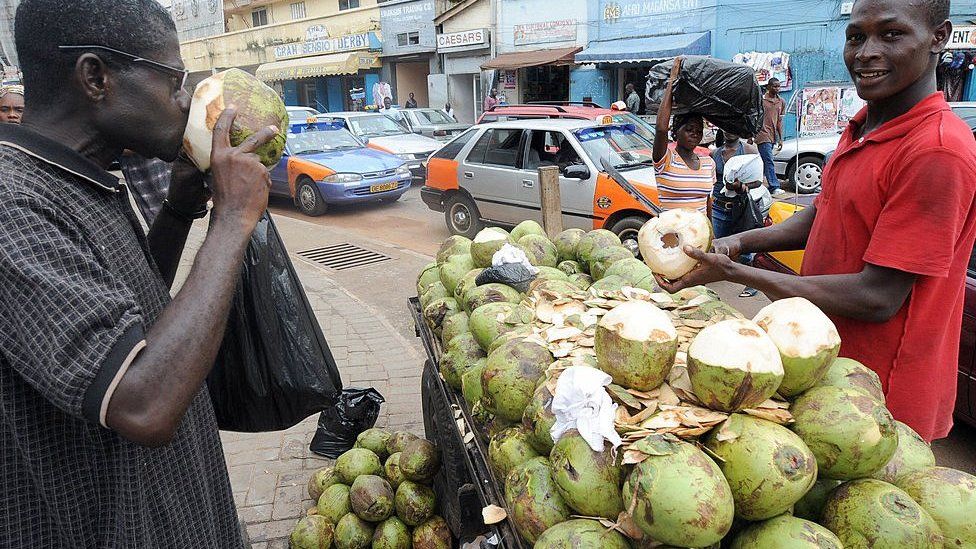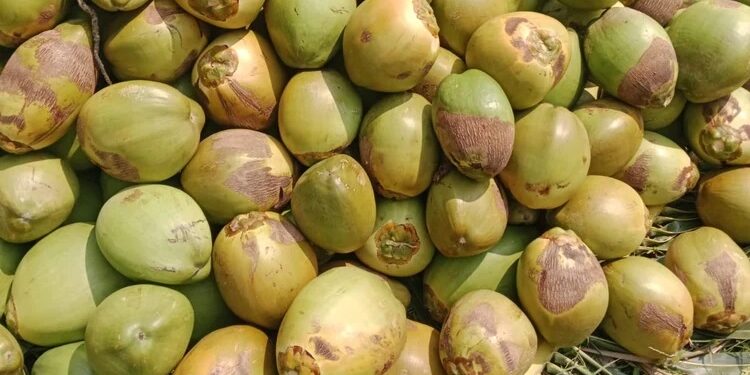From Farm to Fork: Why Ghanaian Farmers Earn Less While Food Prices Soar
By Ebenezer Yamoah
Street food in Ghana is no longer cheap. From kenkey and waakye to a simple coconut drink, prices keep rising, leaving many Ghanaians frustrated. But if farmers are selling their produce cheaply, why are consumers paying so much?
A closer look at the coconut trade from Gomoa Afransi in the Central Region sheds light on this imbalance—and exposes how transport, middlemen, and weak price regulation drive up costs while farmers remain underpaid.
The Farmer’s Reality
At Gomoa Afransi, coconut farmers sell 100 pieces for GHS120, meaning a single coconut costs just GHS1.20 at the farm gate. A farmer selling 3,000 coconuts makes only GHS3,600—meager returns considering the labor and farm inputs required.
This isn’t new. As far back as 2021, coconut sellers told the Ghana News Agency that farm gate prices had climbed from 80 pesewas to GHS1.20, forcing traders to raise their own prices just to break even (Ghana News Agency, 2021).
“We sell and it looks like we are making money, but by the time the food reaches the city, it’s as if we were cheated,” one farmer lamented.
The Distributor’s Burden
Distributors shoulder plucking, carrying, and transport costs. A truck carrying 3,000 coconuts from Gomoa to Accra costs about GHS1,800. Dealers often hire locals or even motorbikes to cart coconuts from the farm to the roadside before loading them onto trucks.
By the time coconuts reach Accra retailers, the price has already jumped to GHS3.20 per coconut. For 3,000 coconuts, distributors make about GHS9,600 after covering their costs.
Some traders also admit to buying on credit from farmers when cash flow is tight. “Sometimes we have to strike a deal with farmers to purchase the fruit on credit,” coconut seller Michael Assefua told GNA.
At the Selling Joint
The sharpest leap in price comes at the retail stage. In Accra today, coconuts sell for GHS7–10 each. At an average of GHS8, one truckload of 3,000 coconuts generates GHS24,000 in sales.
The gap is staggering: while the farmer earns GHS3,600, the final sellers take home up to GHS24,000—a difference of GHS20,400 on the same load of coconuts.
Even a recent caller to Angel FM’s Morning Show revealed that while farmers in Gomoa sell at ₵120 per 100 pieces, Accra traders resell at nearly ₵10 per coconut, making profits of up to ₵18,000 after transport (Angel FM, 2025). The revelation sparked heated debate about fairness and market regulation.
What Sellers Say
For traders like Kofi Asare, the rising farm price and extra costs explain why consumers are paying more. “We used to buy at 80 pesewas per coconut, now it’s GHS1.20. If we don’t sell at GHS2.00 or GHS2.50, we won’t break even,” he told GNA (Ghana News Agency, 2021).
Others point to municipal levies and day-to-day expenses. Though they don’t pay direct taxes, coconut sellers in Koforidua, Accra, and other markets contribute GHS1 daily market levies to local assemblies.
For consumers like Joseph Boama, however, the burden is heavy. “I was advised by a health practitioner to drink coconut daily for my wellbeing. For the past five years I have been buying, but now the price is almost too high,” he explained.

Photo credit: kdamtsi.com
A System Out of Balance
The coconut trade mirrors the broader food system. Tomatoes, onions, plantain, and maize follow the same pattern: farmers sell cheap, middlemen and transport inflate costs, and retailers pocket the most.
Reports from MoFA confirm that similar disparities exist across staple crops, further highlighting how much transport and urban market dynamics inflate prices (MoFA, 2024).
As the Angel FM discussion showed, this isn’t just about price gaps—it’s about regulation. The Consumer Protection Agency has repeatedly called for the long-delayed Price Control Bill to stabilize the market, but uncertainty remains about when it will finally be passed (Consumer Protection Agency, 2023).
Until then, farmers will continue to struggle at the bottom of the chain while urban consumers pay ever-higher prices for basic foods.
The Numbers Don’t Lie
-
Farmer (3,000 coconuts): GHS3,600
-
Distributor: GHS9,600
-
Retailer: Up to GHS24,000
-
Gap: GHS20,400
From farm to fork, the imbalance is clear. One farmer’s harvest becomes someone else’s fortune.
Do the maths. The system is broken.
Endnotes
-
Ghana News Agency (2021). Coconut sellers lament high prices at Gomoa Afransi. Accra: GNA.
-
Angel FM (2025). Morning Show discussion on coconut trade and food prices. Accra: Angel Broadcasting Network, September 2025.
-
Ministry of Food and Agriculture (MoFA) (2024). Agricultural Market Prices Report. Accra: MoFA Statistics, Research and Information Directorate.
-
Consumer Protection Agency Ghana (2023). Statement on the Price Control Bill and consumer protection in Ghana. Accra: CPA Ghana.




